History Essay: A Comparative Analysis of Indian Nationalist Movements
VerifiedAdded on 2021/04/16
|8
|1695
|436
Essay
AI Summary
This essay provides a comparative analysis of two prominent Indian nationalist movements during the British rule in India: the movements led by Mohandas K. Gandhi and Subhas Chandra Bose. It explores their differing ideologies, tactics, and visions for an independent India. Gandhi's approach of non-violent resistance, advocating for Spiritual Swaraj and dominion status, is contrasted with Bose's more assertive stance, seeking complete independence and utilizing external alliances with Imperial Japan and Nazi Germany. The essay examines their perspectives on key issues such as complete independence versus dominion status, modernism, industrialization, and education. It also explores how geopolitical factors, such as the Second World War, influenced the weakening of British power. The conclusion highlights the complex interplay of factors that led to India's independence and the enduring impact of both Gandhi's social movements and Bose's strategies.
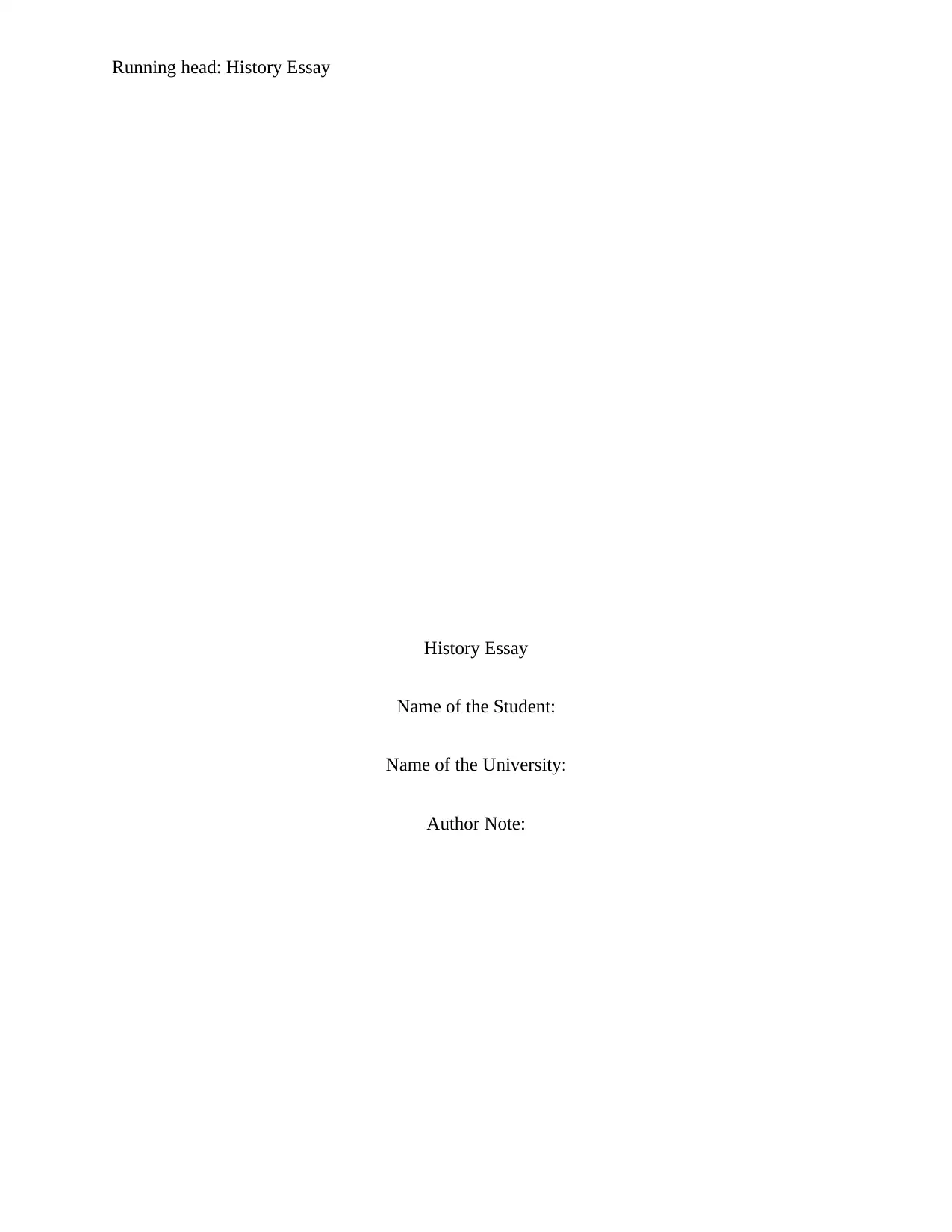
Running head: History Essay
History Essay
Name of the Student:
Name of the University:
Author Note:
History Essay
Name of the Student:
Name of the University:
Author Note:
Paraphrase This Document
Need a fresh take? Get an instant paraphrase of this document with our AI Paraphraser
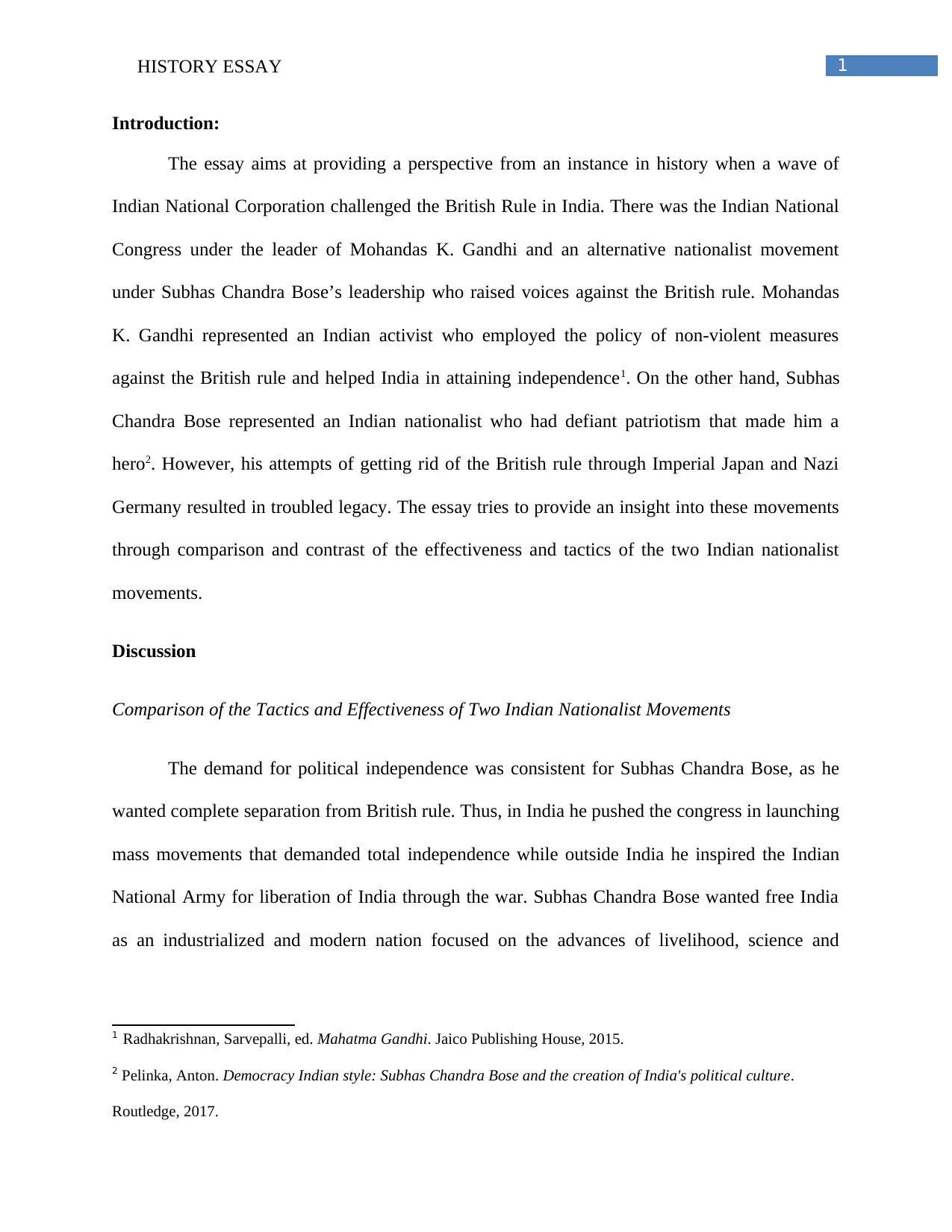
1HISTORY ESSAY
Introduction:
The essay aims at providing a perspective from an instance in history when a wave of
Indian National Corporation challenged the British Rule in India. There was the Indian National
Congress under the leader of Mohandas K. Gandhi and an alternative nationalist movement
under Subhas Chandra Bose’s leadership who raised voices against the British rule. Mohandas
K. Gandhi represented an Indian activist who employed the policy of non-violent measures
against the British rule and helped India in attaining independence1. On the other hand, Subhas
Chandra Bose represented an Indian nationalist who had defiant patriotism that made him a
hero2. However, his attempts of getting rid of the British rule through Imperial Japan and Nazi
Germany resulted in troubled legacy. The essay tries to provide an insight into these movements
through comparison and contrast of the effectiveness and tactics of the two Indian nationalist
movements.
Discussion
Comparison of the Tactics and Effectiveness of Two Indian Nationalist Movements
The demand for political independence was consistent for Subhas Chandra Bose, as he
wanted complete separation from British rule. Thus, in India he pushed the congress in launching
mass movements that demanded total independence while outside India he inspired the Indian
National Army for liberation of India through the war. Subhas Chandra Bose wanted free India
as an industrialized and modern nation focused on the advances of livelihood, science and
1 Radhakrishnan, Sarvepalli, ed. Mahatma Gandhi. Jaico Publishing House, 2015.
2 Pelinka, Anton. Democracy Indian style: Subhas Chandra Bose and the creation of India's political culture.
Routledge, 2017.
Introduction:
The essay aims at providing a perspective from an instance in history when a wave of
Indian National Corporation challenged the British Rule in India. There was the Indian National
Congress under the leader of Mohandas K. Gandhi and an alternative nationalist movement
under Subhas Chandra Bose’s leadership who raised voices against the British rule. Mohandas
K. Gandhi represented an Indian activist who employed the policy of non-violent measures
against the British rule and helped India in attaining independence1. On the other hand, Subhas
Chandra Bose represented an Indian nationalist who had defiant patriotism that made him a
hero2. However, his attempts of getting rid of the British rule through Imperial Japan and Nazi
Germany resulted in troubled legacy. The essay tries to provide an insight into these movements
through comparison and contrast of the effectiveness and tactics of the two Indian nationalist
movements.
Discussion
Comparison of the Tactics and Effectiveness of Two Indian Nationalist Movements
The demand for political independence was consistent for Subhas Chandra Bose, as he
wanted complete separation from British rule. Thus, in India he pushed the congress in launching
mass movements that demanded total independence while outside India he inspired the Indian
National Army for liberation of India through the war. Subhas Chandra Bose wanted free India
as an industrialized and modern nation focused on the advances of livelihood, science and
1 Radhakrishnan, Sarvepalli, ed. Mahatma Gandhi. Jaico Publishing House, 2015.
2 Pelinka, Anton. Democracy Indian style: Subhas Chandra Bose and the creation of India's political culture.
Routledge, 2017.
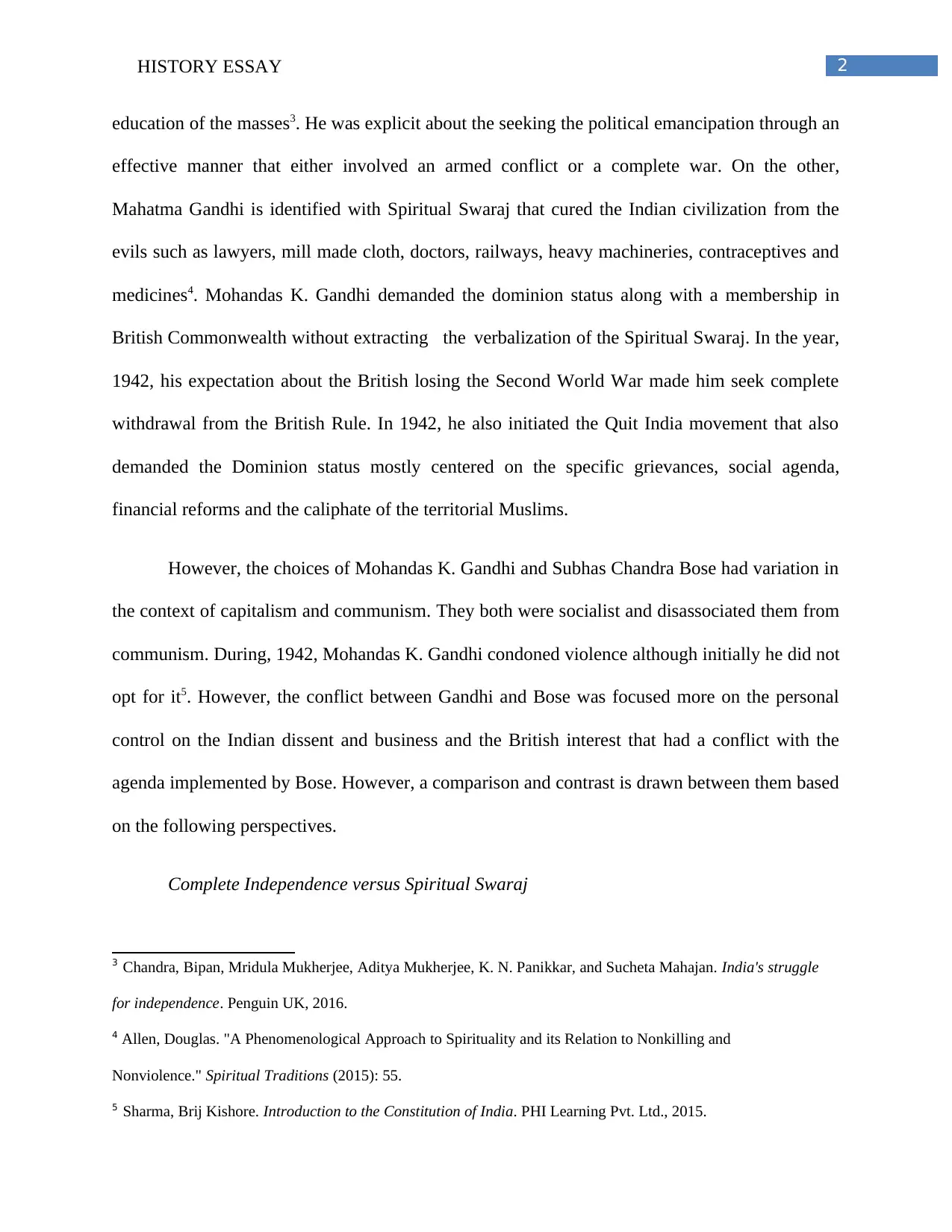
2HISTORY ESSAY
education of the masses3. He was explicit about the seeking the political emancipation through an
effective manner that either involved an armed conflict or a complete war. On the other,
Mahatma Gandhi is identified with Spiritual Swaraj that cured the Indian civilization from the
evils such as lawyers, mill made cloth, doctors, railways, heavy machineries, contraceptives and
medicines4. Mohandas K. Gandhi demanded the dominion status along with a membership in
British Commonwealth without extracting the verbalization of the Spiritual Swaraj. In the year,
1942, his expectation about the British losing the Second World War made him seek complete
withdrawal from the British Rule. In 1942, he also initiated the Quit India movement that also
demanded the Dominion status mostly centered on the specific grievances, social agenda,
financial reforms and the caliphate of the territorial Muslims.
However, the choices of Mohandas K. Gandhi and Subhas Chandra Bose had variation in
the context of capitalism and communism. They both were socialist and disassociated them from
communism. During, 1942, Mohandas K. Gandhi condoned violence although initially he did not
opt for it5. However, the conflict between Gandhi and Bose was focused more on the personal
control on the Indian dissent and business and the British interest that had a conflict with the
agenda implemented by Bose. However, a comparison and contrast is drawn between them based
on the following perspectives.
Complete Independence versus Spiritual Swaraj
3 Chandra, Bipan, Mridula Mukherjee, Aditya Mukherjee, K. N. Panikkar, and Sucheta Mahajan. India's struggle
for independence. Penguin UK, 2016.
4 Allen, Douglas. "A Phenomenological Approach to Spirituality and its Relation to Nonkilling and
Nonviolence." Spiritual Traditions (2015): 55.
5 Sharma, Brij Kishore. Introduction to the Constitution of India. PHI Learning Pvt. Ltd., 2015.
education of the masses3. He was explicit about the seeking the political emancipation through an
effective manner that either involved an armed conflict or a complete war. On the other,
Mahatma Gandhi is identified with Spiritual Swaraj that cured the Indian civilization from the
evils such as lawyers, mill made cloth, doctors, railways, heavy machineries, contraceptives and
medicines4. Mohandas K. Gandhi demanded the dominion status along with a membership in
British Commonwealth without extracting the verbalization of the Spiritual Swaraj. In the year,
1942, his expectation about the British losing the Second World War made him seek complete
withdrawal from the British Rule. In 1942, he also initiated the Quit India movement that also
demanded the Dominion status mostly centered on the specific grievances, social agenda,
financial reforms and the caliphate of the territorial Muslims.
However, the choices of Mohandas K. Gandhi and Subhas Chandra Bose had variation in
the context of capitalism and communism. They both were socialist and disassociated them from
communism. During, 1942, Mohandas K. Gandhi condoned violence although initially he did not
opt for it5. However, the conflict between Gandhi and Bose was focused more on the personal
control on the Indian dissent and business and the British interest that had a conflict with the
agenda implemented by Bose. However, a comparison and contrast is drawn between them based
on the following perspectives.
Complete Independence versus Spiritual Swaraj
3 Chandra, Bipan, Mridula Mukherjee, Aditya Mukherjee, K. N. Panikkar, and Sucheta Mahajan. India's struggle
for independence. Penguin UK, 2016.
4 Allen, Douglas. "A Phenomenological Approach to Spirituality and its Relation to Nonkilling and
Nonviolence." Spiritual Traditions (2015): 55.
5 Sharma, Brij Kishore. Introduction to the Constitution of India. PHI Learning Pvt. Ltd., 2015.
⊘ This is a preview!⊘
Do you want full access?
Subscribe today to unlock all pages.

Trusted by 1+ million students worldwide
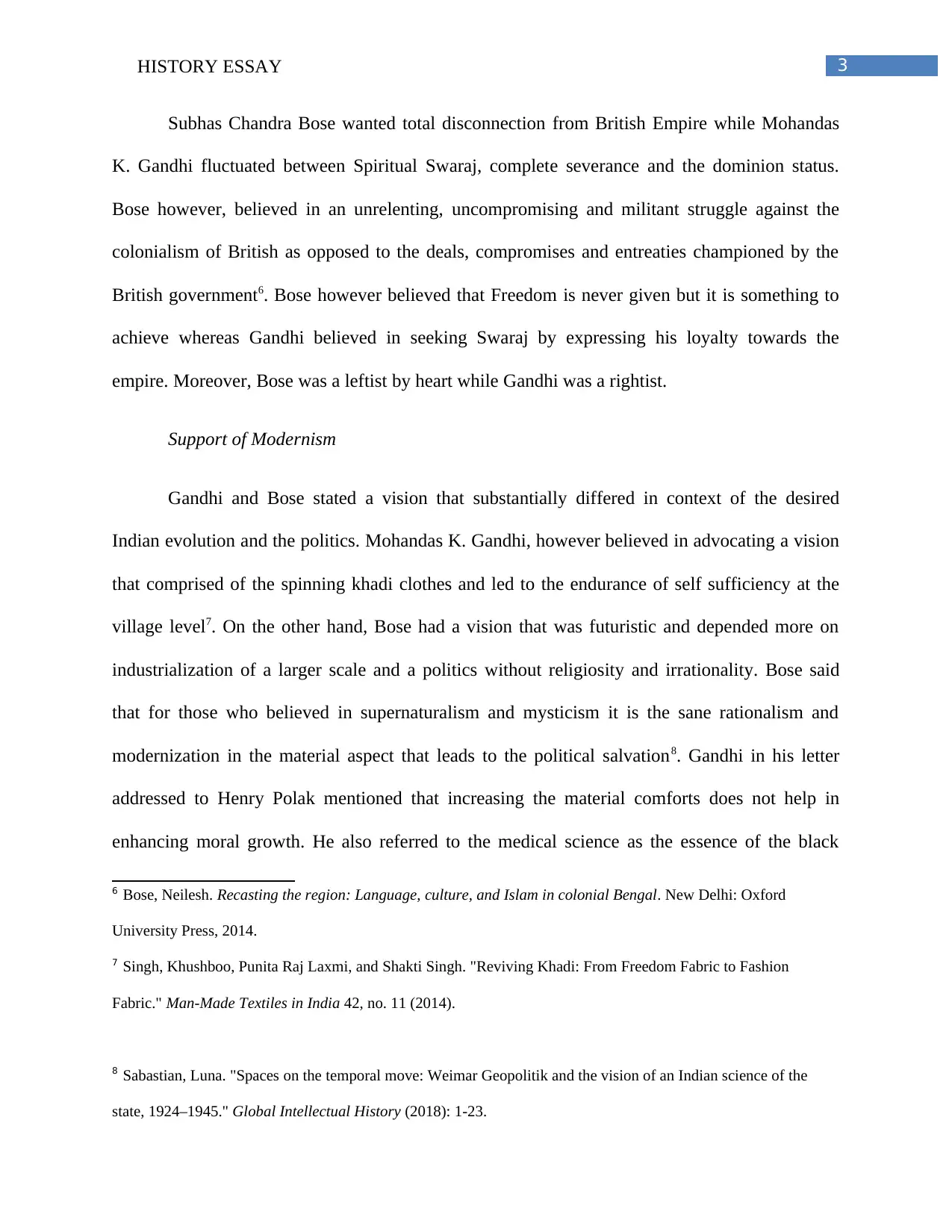
3HISTORY ESSAY
Subhas Chandra Bose wanted total disconnection from British Empire while Mohandas
K. Gandhi fluctuated between Spiritual Swaraj, complete severance and the dominion status.
Bose however, believed in an unrelenting, uncompromising and militant struggle against the
colonialism of British as opposed to the deals, compromises and entreaties championed by the
British government6. Bose however believed that Freedom is never given but it is something to
achieve whereas Gandhi believed in seeking Swaraj by expressing his loyalty towards the
empire. Moreover, Bose was a leftist by heart while Gandhi was a rightist.
Support of Modernism
Gandhi and Bose stated a vision that substantially differed in context of the desired
Indian evolution and the politics. Mohandas K. Gandhi, however believed in advocating a vision
that comprised of the spinning khadi clothes and led to the endurance of self sufficiency at the
village level7. On the other hand, Bose had a vision that was futuristic and depended more on
industrialization of a larger scale and a politics without religiosity and irrationality. Bose said
that for those who believed in supernaturalism and mysticism it is the sane rationalism and
modernization in the material aspect that leads to the political salvation8. Gandhi in his letter
addressed to Henry Polak mentioned that increasing the material comforts does not help in
enhancing moral growth. He also referred to the medical science as the essence of the black
6 Bose, Neilesh. Recasting the region: Language, culture, and Islam in colonial Bengal. New Delhi: Oxford
University Press, 2014.
7 Singh, Khushboo, Punita Raj Laxmi, and Shakti Singh. "Reviving Khadi: From Freedom Fabric to Fashion
Fabric." Man-Made Textiles in India 42, no. 11 (2014).
8 Sabastian, Luna. "Spaces on the temporal move: Weimar Geopolitik and the vision of an Indian science of the
state, 1924–1945." Global Intellectual History (2018): 1-23.
Subhas Chandra Bose wanted total disconnection from British Empire while Mohandas
K. Gandhi fluctuated between Spiritual Swaraj, complete severance and the dominion status.
Bose however, believed in an unrelenting, uncompromising and militant struggle against the
colonialism of British as opposed to the deals, compromises and entreaties championed by the
British government6. Bose however believed that Freedom is never given but it is something to
achieve whereas Gandhi believed in seeking Swaraj by expressing his loyalty towards the
empire. Moreover, Bose was a leftist by heart while Gandhi was a rightist.
Support of Modernism
Gandhi and Bose stated a vision that substantially differed in context of the desired
Indian evolution and the politics. Mohandas K. Gandhi, however believed in advocating a vision
that comprised of the spinning khadi clothes and led to the endurance of self sufficiency at the
village level7. On the other hand, Bose had a vision that was futuristic and depended more on
industrialization of a larger scale and a politics without religiosity and irrationality. Bose said
that for those who believed in supernaturalism and mysticism it is the sane rationalism and
modernization in the material aspect that leads to the political salvation8. Gandhi in his letter
addressed to Henry Polak mentioned that increasing the material comforts does not help in
enhancing moral growth. He also referred to the medical science as the essence of the black
6 Bose, Neilesh. Recasting the region: Language, culture, and Islam in colonial Bengal. New Delhi: Oxford
University Press, 2014.
7 Singh, Khushboo, Punita Raj Laxmi, and Shakti Singh. "Reviving Khadi: From Freedom Fabric to Fashion
Fabric." Man-Made Textiles in India 42, no. 11 (2014).
8 Sabastian, Luna. "Spaces on the temporal move: Weimar Geopolitik and the vision of an Indian science of the
state, 1924–1945." Global Intellectual History (2018): 1-23.
Paraphrase This Document
Need a fresh take? Get an instant paraphrase of this document with our AI Paraphraser
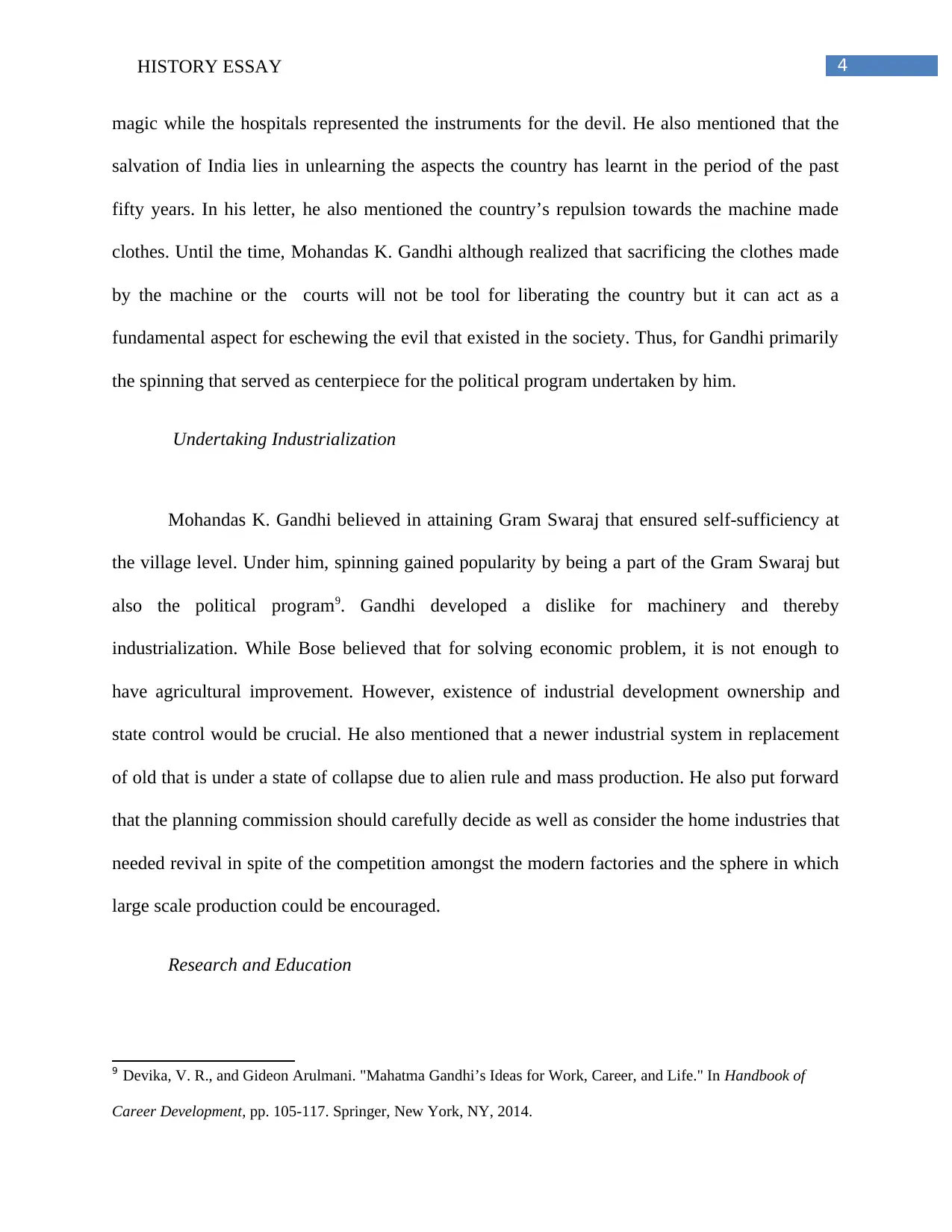
4HISTORY ESSAY
magic while the hospitals represented the instruments for the devil. He also mentioned that the
salvation of India lies in unlearning the aspects the country has learnt in the period of the past
fifty years. In his letter, he also mentioned the country’s repulsion towards the machine made
clothes. Until the time, Mohandas K. Gandhi although realized that sacrificing the clothes made
by the machine or the courts will not be tool for liberating the country but it can act as a
fundamental aspect for eschewing the evil that existed in the society. Thus, for Gandhi primarily
the spinning that served as centerpiece for the political program undertaken by him.
Undertaking Industrialization
Mohandas K. Gandhi believed in attaining Gram Swaraj that ensured self-sufficiency at
the village level. Under him, spinning gained popularity by being a part of the Gram Swaraj but
also the political program9. Gandhi developed a dislike for machinery and thereby
industrialization. While Bose believed that for solving economic problem, it is not enough to
have agricultural improvement. However, existence of industrial development ownership and
state control would be crucial. He also mentioned that a newer industrial system in replacement
of old that is under a state of collapse due to alien rule and mass production. He also put forward
that the planning commission should carefully decide as well as consider the home industries that
needed revival in spite of the competition amongst the modern factories and the sphere in which
large scale production could be encouraged.
Research and Education
9 Devika, V. R., and Gideon Arulmani. "Mahatma Gandhi’s Ideas for Work, Career, and Life." In Handbook of
Career Development, pp. 105-117. Springer, New York, NY, 2014.
magic while the hospitals represented the instruments for the devil. He also mentioned that the
salvation of India lies in unlearning the aspects the country has learnt in the period of the past
fifty years. In his letter, he also mentioned the country’s repulsion towards the machine made
clothes. Until the time, Mohandas K. Gandhi although realized that sacrificing the clothes made
by the machine or the courts will not be tool for liberating the country but it can act as a
fundamental aspect for eschewing the evil that existed in the society. Thus, for Gandhi primarily
the spinning that served as centerpiece for the political program undertaken by him.
Undertaking Industrialization
Mohandas K. Gandhi believed in attaining Gram Swaraj that ensured self-sufficiency at
the village level. Under him, spinning gained popularity by being a part of the Gram Swaraj but
also the political program9. Gandhi developed a dislike for machinery and thereby
industrialization. While Bose believed that for solving economic problem, it is not enough to
have agricultural improvement. However, existence of industrial development ownership and
state control would be crucial. He also mentioned that a newer industrial system in replacement
of old that is under a state of collapse due to alien rule and mass production. He also put forward
that the planning commission should carefully decide as well as consider the home industries that
needed revival in spite of the competition amongst the modern factories and the sphere in which
large scale production could be encouraged.
Research and Education
9 Devika, V. R., and Gideon Arulmani. "Mahatma Gandhi’s Ideas for Work, Career, and Life." In Handbook of
Career Development, pp. 105-117. Springer, New York, NY, 2014.
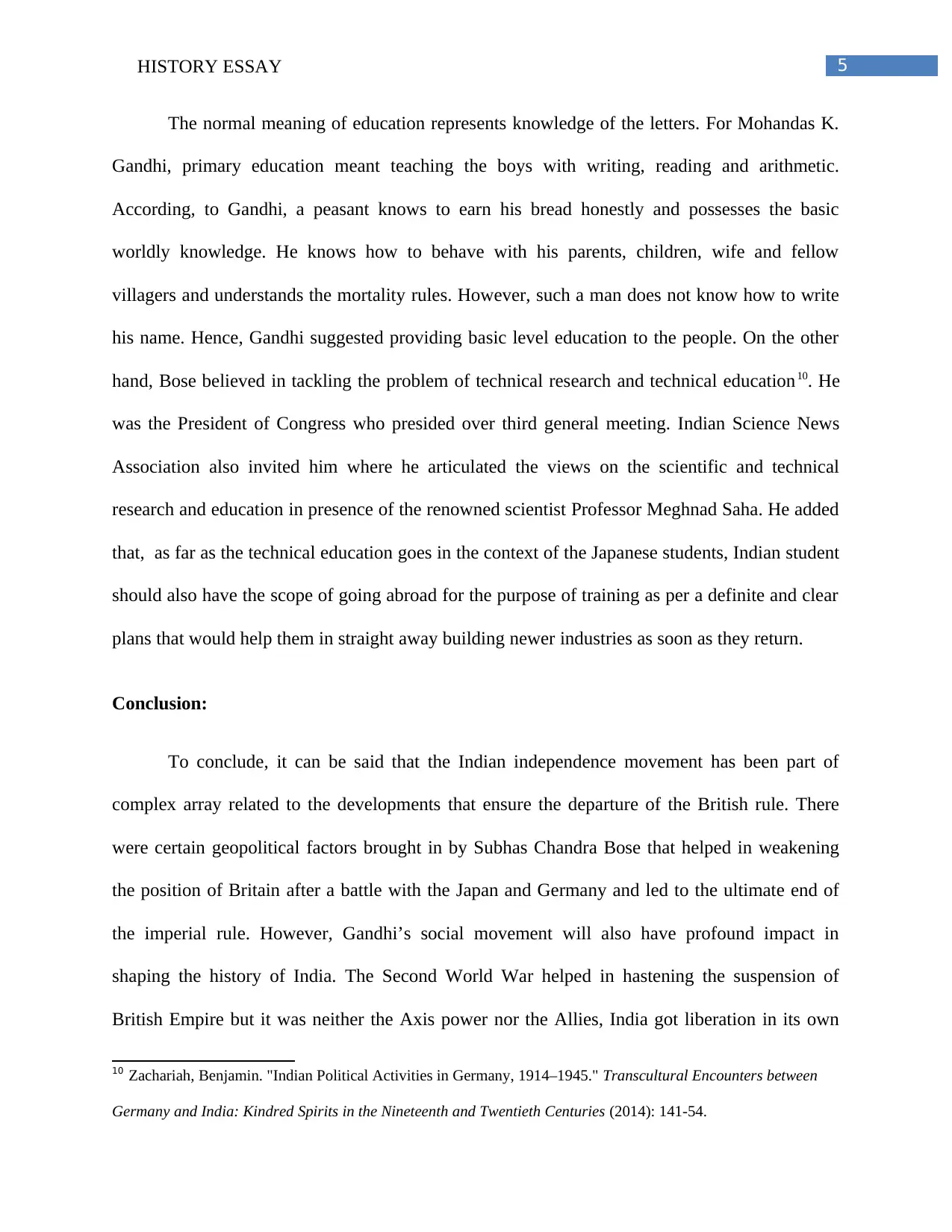
5HISTORY ESSAY
The normal meaning of education represents knowledge of the letters. For Mohandas K.
Gandhi, primary education meant teaching the boys with writing, reading and arithmetic.
According, to Gandhi, a peasant knows to earn his bread honestly and possesses the basic
worldly knowledge. He knows how to behave with his parents, children, wife and fellow
villagers and understands the mortality rules. However, such a man does not know how to write
his name. Hence, Gandhi suggested providing basic level education to the people. On the other
hand, Bose believed in tackling the problem of technical research and technical education10. He
was the President of Congress who presided over third general meeting. Indian Science News
Association also invited him where he articulated the views on the scientific and technical
research and education in presence of the renowned scientist Professor Meghnad Saha. He added
that, as far as the technical education goes in the context of the Japanese students, Indian student
should also have the scope of going abroad for the purpose of training as per a definite and clear
plans that would help them in straight away building newer industries as soon as they return.
Conclusion:
To conclude, it can be said that the Indian independence movement has been part of
complex array related to the developments that ensure the departure of the British rule. There
were certain geopolitical factors brought in by Subhas Chandra Bose that helped in weakening
the position of Britain after a battle with the Japan and Germany and led to the ultimate end of
the imperial rule. However, Gandhi’s social movement will also have profound impact in
shaping the history of India. The Second World War helped in hastening the suspension of
British Empire but it was neither the Axis power nor the Allies, India got liberation in its own
10 Zachariah, Benjamin. "Indian Political Activities in Germany, 1914–1945." Transcultural Encounters between
Germany and India: Kindred Spirits in the Nineteenth and Twentieth Centuries (2014): 141-54.
The normal meaning of education represents knowledge of the letters. For Mohandas K.
Gandhi, primary education meant teaching the boys with writing, reading and arithmetic.
According, to Gandhi, a peasant knows to earn his bread honestly and possesses the basic
worldly knowledge. He knows how to behave with his parents, children, wife and fellow
villagers and understands the mortality rules. However, such a man does not know how to write
his name. Hence, Gandhi suggested providing basic level education to the people. On the other
hand, Bose believed in tackling the problem of technical research and technical education10. He
was the President of Congress who presided over third general meeting. Indian Science News
Association also invited him where he articulated the views on the scientific and technical
research and education in presence of the renowned scientist Professor Meghnad Saha. He added
that, as far as the technical education goes in the context of the Japanese students, Indian student
should also have the scope of going abroad for the purpose of training as per a definite and clear
plans that would help them in straight away building newer industries as soon as they return.
Conclusion:
To conclude, it can be said that the Indian independence movement has been part of
complex array related to the developments that ensure the departure of the British rule. There
were certain geopolitical factors brought in by Subhas Chandra Bose that helped in weakening
the position of Britain after a battle with the Japan and Germany and led to the ultimate end of
the imperial rule. However, Gandhi’s social movement will also have profound impact in
shaping the history of India. The Second World War helped in hastening the suspension of
British Empire but it was neither the Axis power nor the Allies, India got liberation in its own
10 Zachariah, Benjamin. "Indian Political Activities in Germany, 1914–1945." Transcultural Encounters between
Germany and India: Kindred Spirits in the Nineteenth and Twentieth Centuries (2014): 141-54.
⊘ This is a preview!⊘
Do you want full access?
Subscribe today to unlock all pages.

Trusted by 1+ million students worldwide

6HISTORY ESSAY
terms. Gandhi put forward a model that represented an ecosystem with complex social
movement while Bose believed in complete independence from British Rule.
terms. Gandhi put forward a model that represented an ecosystem with complex social
movement while Bose believed in complete independence from British Rule.
Paraphrase This Document
Need a fresh take? Get an instant paraphrase of this document with our AI Paraphraser
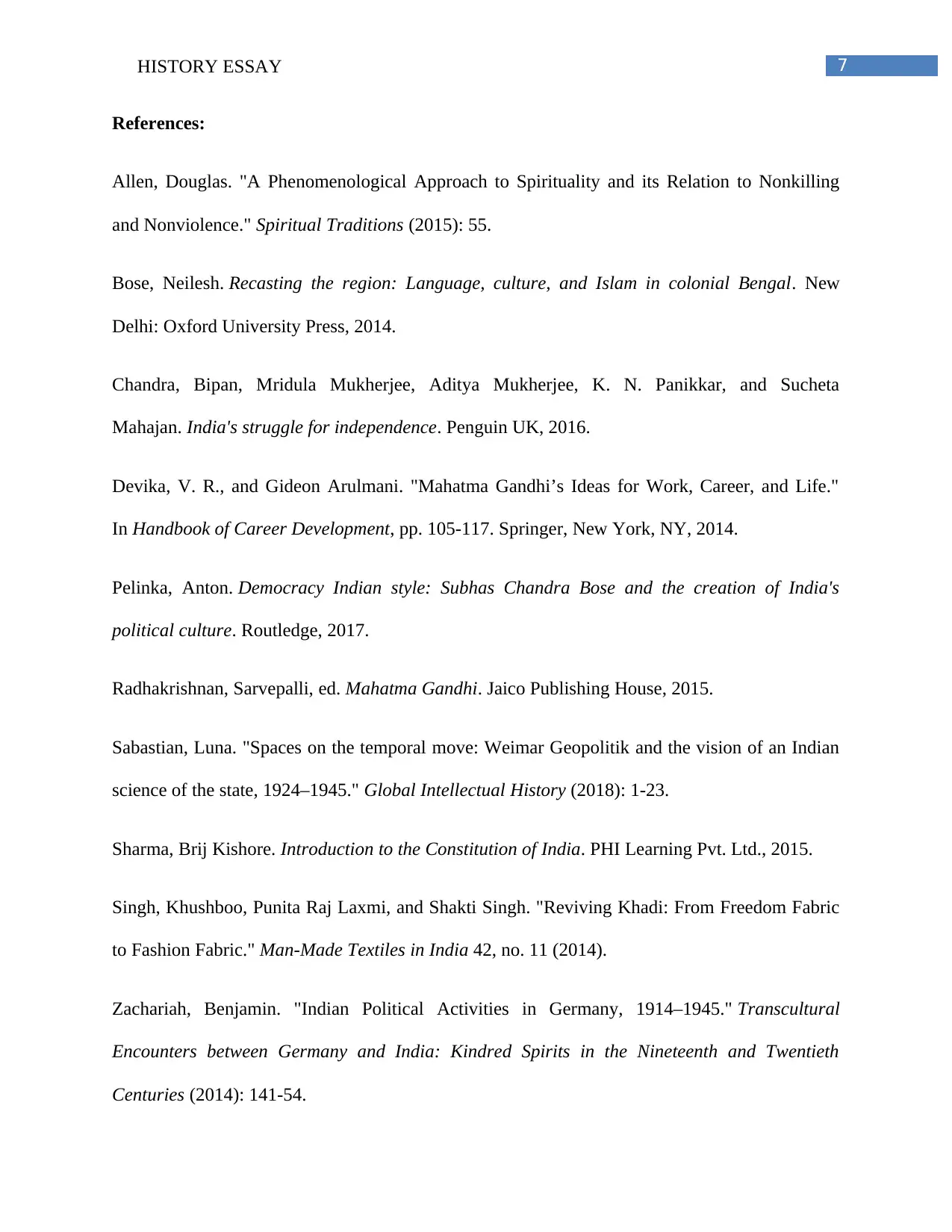
7HISTORY ESSAY
References:
Allen, Douglas. "A Phenomenological Approach to Spirituality and its Relation to Nonkilling
and Nonviolence." Spiritual Traditions (2015): 55.
Bose, Neilesh. Recasting the region: Language, culture, and Islam in colonial Bengal. New
Delhi: Oxford University Press, 2014.
Chandra, Bipan, Mridula Mukherjee, Aditya Mukherjee, K. N. Panikkar, and Sucheta
Mahajan. India's struggle for independence. Penguin UK, 2016.
Devika, V. R., and Gideon Arulmani. "Mahatma Gandhi’s Ideas for Work, Career, and Life."
In Handbook of Career Development, pp. 105-117. Springer, New York, NY, 2014.
Pelinka, Anton. Democracy Indian style: Subhas Chandra Bose and the creation of India's
political culture. Routledge, 2017.
Radhakrishnan, Sarvepalli, ed. Mahatma Gandhi. Jaico Publishing House, 2015.
Sabastian, Luna. "Spaces on the temporal move: Weimar Geopolitik and the vision of an Indian
science of the state, 1924–1945." Global Intellectual History (2018): 1-23.
Sharma, Brij Kishore. Introduction to the Constitution of India. PHI Learning Pvt. Ltd., 2015.
Singh, Khushboo, Punita Raj Laxmi, and Shakti Singh. "Reviving Khadi: From Freedom Fabric
to Fashion Fabric." Man-Made Textiles in India 42, no. 11 (2014).
Zachariah, Benjamin. "Indian Political Activities in Germany, 1914–1945." Transcultural
Encounters between Germany and India: Kindred Spirits in the Nineteenth and Twentieth
Centuries (2014): 141-54.
References:
Allen, Douglas. "A Phenomenological Approach to Spirituality and its Relation to Nonkilling
and Nonviolence." Spiritual Traditions (2015): 55.
Bose, Neilesh. Recasting the region: Language, culture, and Islam in colonial Bengal. New
Delhi: Oxford University Press, 2014.
Chandra, Bipan, Mridula Mukherjee, Aditya Mukherjee, K. N. Panikkar, and Sucheta
Mahajan. India's struggle for independence. Penguin UK, 2016.
Devika, V. R., and Gideon Arulmani. "Mahatma Gandhi’s Ideas for Work, Career, and Life."
In Handbook of Career Development, pp. 105-117. Springer, New York, NY, 2014.
Pelinka, Anton. Democracy Indian style: Subhas Chandra Bose and the creation of India's
political culture. Routledge, 2017.
Radhakrishnan, Sarvepalli, ed. Mahatma Gandhi. Jaico Publishing House, 2015.
Sabastian, Luna. "Spaces on the temporal move: Weimar Geopolitik and the vision of an Indian
science of the state, 1924–1945." Global Intellectual History (2018): 1-23.
Sharma, Brij Kishore. Introduction to the Constitution of India. PHI Learning Pvt. Ltd., 2015.
Singh, Khushboo, Punita Raj Laxmi, and Shakti Singh. "Reviving Khadi: From Freedom Fabric
to Fashion Fabric." Man-Made Textiles in India 42, no. 11 (2014).
Zachariah, Benjamin. "Indian Political Activities in Germany, 1914–1945." Transcultural
Encounters between Germany and India: Kindred Spirits in the Nineteenth and Twentieth
Centuries (2014): 141-54.
1 out of 8
Your All-in-One AI-Powered Toolkit for Academic Success.
+13062052269
info@desklib.com
Available 24*7 on WhatsApp / Email
![[object Object]](/_next/static/media/star-bottom.7253800d.svg)
Unlock your academic potential
Copyright © 2020–2025 A2Z Services. All Rights Reserved. Developed and managed by ZUCOL.

